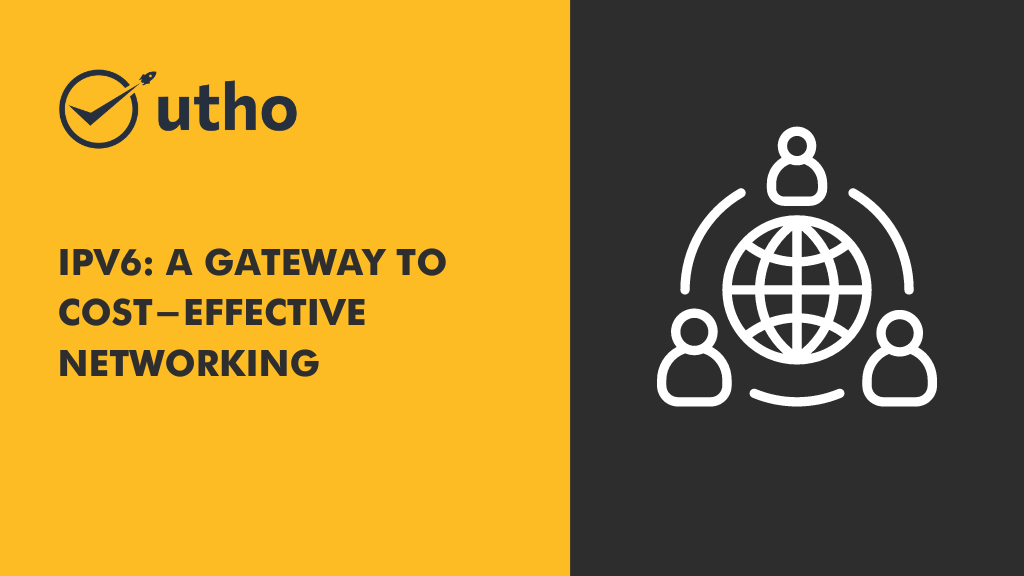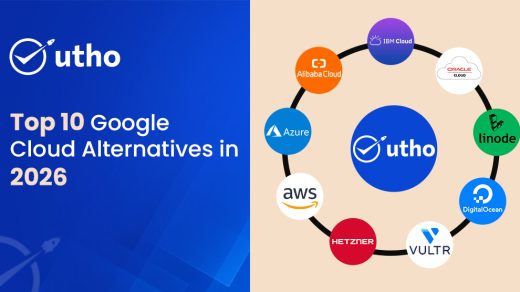Today's digital world is constantly changing, and having a strong communication system is crucial to staying competitive. A key part of this system is the Internet Protocol (IP), which is a set of rules that helps devices communicate over the internet. Every device connected to a network gets a unique identifier called an IP address, which allows them to send and receive data.
IPv4 has been the main version of IP used for a long time. But because the internet has grown so much, we're running out of IPv4 addresses. This is where IPv6 comes in. It's a newer standard that's being rolled out to replace IPv4. Many companies and organizations are switching because it offers a practically unlimited number of addresses, which solves the problem of running out of them with IPv4.
How does IPv6 adoption contribute to cost optimization in networking?
IPv6 adoption contributes to cost optimization in networking in several ways:
Efficient Addressing: IPv6 provides a significantly larger address space compared to IPv4. With Internet Protocol version 6, there are more than enough addresses to accommodate the growing number of devices connected to the internet. This eliminates the need for costly workarounds like Network Address Translation (NAT), which can be complex to manage and can incur additional hardware and administrative costs.
Simplified Network Architecture: IPv6 simplifies network architecture by removing the need for NAT and allowing for end-to-end connectivity. This simplification can reduce the complexity of network configurations and maintenance, leading to cost savings in terms of reduced equipment, configuration, and support requirements.
Enhanced Security: IPv6 includes built-in support for IPsec (Internet Protocol Security), which provides encryption and authentication for network traffic. By integrating security features at the protocol level, organizations can potentially reduce the need for additional security measures and investments in third-party security solutions, thus optimizing costs.
Future-Proofing: As IPv4 addresses become increasingly scarce, the cost of acquiring IPv4 addresses from the dwindling pool of available addresses can be significant. IPv6 adoption future-proofs networks by providing an abundant and scalable address space, reducing the need for costly acquisitions of IPv4 addresses as well as potential disruptions caused by address exhaustion.
Operational Efficiency: IPv6 adoption can lead to operational efficiencies by streamlining network management tasks. With Internet Protocol version 6, network administrators can benefit from auto-configuration capabilities, simplified routing protocols, and improved scalability, all of which contribute to reduced operational overhead and lower costs associated with network management and troubleshooting.
Overall, IPv6 adoption offers a cost-effective solution for meeting the growing demands of the internet while simplifying network operations and enhancing security, ultimately leading to significant cost optimization in networking.
Which industries or sectors are likely to benefit the most from IPv6 adoption in terms of cost optimization?
Several industries or sectors are likely to benefit significantly from IPv6 adoption in terms of cost optimization:
Telecommunications: Telecommunications companies stand to gain substantial cost savings through IPv6 adoption. With the increasing number of connected devices and the growing demand for data-intensive services like video streaming and IoT applications, IPv6's larger address space and efficient routing capabilities can help telecom providers optimize their network infrastructure, reduce operational costs, and accommodate future growth without the need for costly workarounds.
Internet Service Providers (ISPs): ISPs play a crucial role in the adoption and deployment of IPv6, as they are responsible for providing internet connectivity to users. IPv6 adoption enables ISPs to efficiently allocate IP addresses to their customers without the constraints of IPv4 address scarcity. By transitioning to Internet Protocol version 6, ISPs can streamline their network operations, reduce the reliance on IPv4 address leasing, and avoid the costs associated with IPv4 address acquisitions.
Cloud Service Providers: Cloud service providers rely heavily on scalable and efficient networking infrastructure to deliver services to their customers. IPv6 adoption allows cloud providers to expand their infrastructure while minimizing costs associated with IPv4 address management, NAT traversal, and network complexity. Additionally, IPv6's built-in support for IPsec enhances security for data transmitted over cloud networks, potentially reducing the need for additional security investments.
Large Enterprises: Large enterprises with extensive networking requirements can benefit from IPv6 adoption by optimizing their internal network infrastructure and reducing the reliance on IPv4 address management solutions. Internet Protocol version 6 enables enterprises to support a growing number of connected devices, facilitate seamless communication between different departments and locations, and streamline network management processes, leading to cost savings in terms of equipment, maintenance, and operational overhead.
Government and Public Sector: Government agencies and public sector organizations often manage large-scale network infrastructures to deliver services to citizens and employees. Internet Protocol version 6 adoption in these sectors can lead to significant cost savings by eliminating the need for IPv4 address acquisitions, reducing network complexity, and enhancing security capabilities. Additionally, Internet Protocol version 6 enables interoperability and communication between different government agencies and systems, streamlining administrative processes and improving overall efficiency.
Overall, industries and sectors that rely heavily on scalable, efficient, and secure networking infrastructure are likely to benefit the most from IPv6 adoption in terms of cost optimization.
How do managed service providers and cloud solutions assist organizations with IPv6 adoption, impacting cost optimization strategies?
Managed service providers (MSPs) and cloud-based solutions play a crucial role in facilitating IPv6 adoption for organizations by providing expertise, infrastructure, and services tailored to support the transition to IPv6. This support significantly impacts cost optimization strategies in several ways:
Expertise and Guidance: MSPs often have specialized knowledge and experience in IPv6 deployment and can offer guidance to organizations throughout the adoption process. They can assess the organization's current infrastructure, develop an IPv6 migration plan, and provide recommendations for optimizing costs while transitioning to Internet Protocol version 6.
Infrastructure Support: Cloud-based solutions offered by MSPs provide scalable and flexible infrastructure resources for organizations to deploy IPv6-enabled services and applications. By leveraging cloud platforms that support IPv6, organizations can avoid upfront investments in hardware and infrastructure, reduce operational costs, and scale resources as needed based on demand.
IPv6-Enabled Services: MSPs may offer IPv6-enabled services such as managed network services, security solutions, and communication platforms that are designed to support IPv6 natively. By utilizing these services, organizations can accelerate their IPv6 adoption efforts while minimizing disruptions to their existing operations and optimizing costs associated with network management and security.
Efficient Migration Strategies: MSPs can assist organizations in developing efficient migration strategies that prioritize cost optimization. This may include phased migration approaches, prioritizing critical systems and services for IPv6 deployment, and leveraging automation and orchestration tools to streamline the migration process and reduce manual effort and associated costs.
Compliance and Risk Management: MSPs help organizations navigate compliance requirements and manage risks associated with IPv6 adoption. By ensuring compliance with industry standards and regulations, as well as implementing robust security measures, MSPs help organizations mitigate potential risks and avoid costly security breaches or compliance penalties.
Overall, managed service providers and cloud-based solutions play a vital role in facilitating IPv6 adoption for organizations by providing expertise, infrastructure, and services tailored to support the transition. By leveraging the support of MSPs and cloud-based solutions, organizations can optimize costs, accelerate their IPv6 adoption efforts, and ensure a smooth transition to the next-generation Internet protocol.
How can Utho Cloud assist with IPv6 implementation?
Utho Cloud can assist with Internet Protocol version 6 implementation in several ways:
Native IPv6 Support: Utho Cloud provides native support for IPv6, allowing organizations to easily enable and configure IPv6 addresses for their cloud resources. This means that users can deploy and manage IPv6-enabled applications and services without the need for complex workarounds or additional configurations.
IPv6-Enabled Networking Services: Utho Cloud offers a range of networking services that are IPv6-enabled, including Virtual Cloud Networks (VCNs), load balancers, and DNS services. These services allow organizations to build and manage IPv6-capable network architectures in the cloud, facilitating seamless communication between IPv6-enabled resources.
Migration and Transition Assistance: Utho Cloud provides tools and resources to assist organizations with the migration and transition to IPv6. This includes guidance documentation, best practices, and migration services to help organizations plan and execute their IPv6 adoption strategies effectively.
Security and Compliance: Utho Cloud includes built-in security features and compliance controls to ensure the secure deployment and management of IPv6-enabled resources. This includes support for Internet Protocol version 6-specific security protocols and standards, such as IPsec, to protect data transmitted over IPv6 networks.
Scalability and Performance: Utho Cloud offers scalable and high-performance infrastructure to support the deployment of IPv6-enabled applications and services. With Utho Cloud's global network of data centers and high-speed connectivity, organizations can ensure reliable and efficient access to their IPv6 resources from anywhere in the world.
Overall, Utho Cloud provides comprehensive support for IPv6 implementation, offering native IPv6 support, IPv6-enabled networking services, migration assistance, security features, and scalable infrastructure to help organizations seamlessly transition to IPv6 and leverage its benefits in the cloud.
How do small and medium-sized enterprises (SMEs) handle IPv6 adoption, and what are the cost challenges they face compared to larger companies?
Small and medium-sized enterprises (SMEs) are approaching IPv6 adoption in the market by taking strategic steps to address their specific needs and challenges. Here's how they're navigating this transition and the unique cost optimization challenges they face compared to larger enterprises:
Resource Constraints: SMEs often have limited resources, both in terms of budget and technical expertise. To navigate IPv6 adoption, SMEs may focus on prioritizing essential infrastructure upgrades and leveraging external support, such as consulting services or managed service providers, to supplement their internal capabilities.
Budget Limitations: Cost considerations play a significant role for SMEs, who may have tighter budgets compared to larger enterprises. While Internet Protocol version 6 adoption is essential for future-proofing their networks, SMEs must carefully evaluate the costs associated with hardware upgrades, software licenses, training, and potential disruptions to their operations during the transition.
Vendor Support and Compatibility: SMEs may face challenges in finding affordable hardware and software solutions that fully support IPv6. Some legacy systems and applications may require updates or replacements to ensure compatibility with IPv6, which can incur additional costs and complexity for SMEs with limited IT resources.
Risk Management: For SMEs, the risks associated with IPv6 adoption, such as potential compatibility issues or security vulnerabilities, can have a disproportionate impact on their operations. SMEs must prioritize risk management strategies and invest in robust security measures to mitigate these risks effectively.
Scalability and Growth: While SMEs may have smaller networks compared to larger enterprises, scalability remains a crucial consideration. IPv6 adoption allows SMEs to accommodate future growth and expansion without facing the constraints of IPv4 address exhaustion. However, SMEs must carefully plan for scalability to ensure that their network infrastructure can support their evolving business needs in a cost-effective manner.
SMEs are navigating Internet Protocol version 6 adoption by focusing on prioritizing essential upgrades, managing budget constraints, seeking vendor support, mitigating risks, and planning for scalability. While they face unique challenges compared to larger enterprises, SMEs can leverage external support, strategic planning, and careful cost management to optimize their IPv6 adoption efforts within their budgetary constraints.
Transitioning to IPv6 offers significant cost-saving benefits for businesses. While smaller enterprises may face challenges due to limited resources, strategic planning and seeking support can help ease the process. Embracing IPv6 not only enhances connectivity but also prepares businesses for future growth and scalability in the digital world.



